Chapter: Network Programming and Management : Elementary TCP Sockets
Socket Address Structure SAS
Socket Address Structure SAS:
This SAS is between application and kernal. An
address conversion function translates between text representation of an
address and binary value that makes up SAS. IPv4 uses inet_addr and inet_ntoa.
But inet_pton and inet_ntop handle IPv4 and IPv6. Above functiuons are protocol
dependent. However the functions starting with sock are protocol independent.
Most socket functions require a pointer to a socket address structure as an
argument.
IPv4 Socket AS: It is defined as follows:
# include <netinet / in.h>
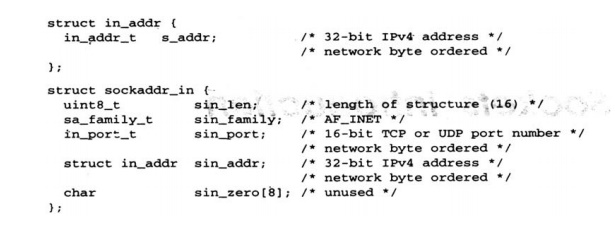
sin_len, added in 4.3 BSD, is not normally
supported by many vendors. It facilitates handling of variable length socket
address structures.
Various data types that are commonly used are
listed below:

![]() Length field is never used and set. It
is used within the kernal before routines
that deal with socket address structures from various protocol
families.
Length field is never used and set. It
is used within the kernal before routines
that deal with socket address structures from various protocol
families.
Four socket functions – bind(), connect(), sendto(), sendmsg() -pass socket address structures from application to kernal. All invoke sockargs() in Berkley derived implementation. This function copies socket address structures and explicitly set the sin_len member to the size of the structure that was passed. The other socket functions that pass socket address to the application from kernal accept(), recvfrom(), recvmsg(), getpeername() and getsockname() all set the sin_len member before returning to the process.
sin_port,
sin_family and sin_addr are the
only required for Posix.1g. sin_zero is implemented to keep the structure
length to 16 byte.
Generic
Socket Address Structure.
Socket address structures are always passed by
reference when passed as an arguments to any of the socket functions.
int bind
(int sockfd, struct sockaddr *, socklen_t);
But the socket function that accept these
address structures as pointers must deal with any of these supported protocols.
This calls for the any functions must cast the pointer to the protocol specific
socket address structure to be a pointer to a generic socket address structure.
For example
struct sockaddr_in serv;
bind (sockfd, (struct sockaddr *) &serv,
sizeof(serv));
If we omit the cast, the C compiler generates a
warning of the form incompatible pointer type.
Different socket address structures are :
IPv4 (24 bytes), IPv6 (24 bytes), Unix variable length and Data link variable
length.
IPv6
SAS:
Defined by # include<netinet/in.h>
header. The structure is shown below:
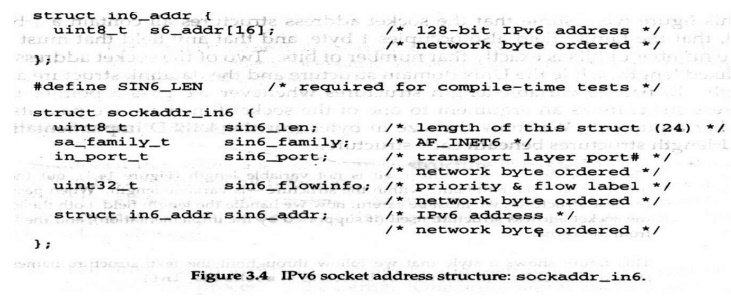
Important points to note are:
•
The SIN_LEN constant must be defined if the
system supports the length members for socket address structures.
The IPv6 family is AF_INET6
The members in this structure are ordered so
that if the sockaddr_in6 structure
is 64 bit aligned, so is the 128 bit sin6_addr
member.
• The sin6_flowinfo member is divided into
three fields o The low order 24 bits are the flow label
o The next 4 bits are the priority o The next 4
bits are reserved.
Comparison
of socket address structure:
Following figure shows the comparison of the
four socket address structures that are encountered.
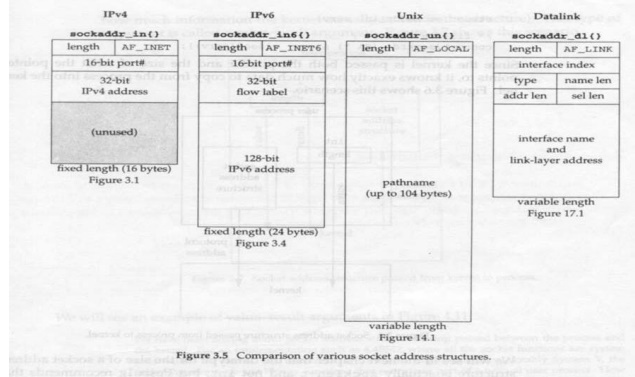
Value
Result Arguments: The
socket address structure is passed to any of the socket function by reference. The length of the structure
is also passed as argument to the function. But the way the length is passed
depends on which direction it is being passed. From the process to the kernal
or kernal to the process.
1. The three functions bind(), connect() and sendto() pass a socket address structure from
the process to the kernal. One argument to these three function is the pointer
to the socket address structure and another argument is the integer size of the
structure.
struct
sockaddr_in serv;
connect
(sockfd, (SA *) & serv, sizeof(serv));
Since the kernal is passed both pointer and the
size of what the pointer points to, it knows exactly how much data to copy from
the process into the kernal. Following figures shows this scenario:
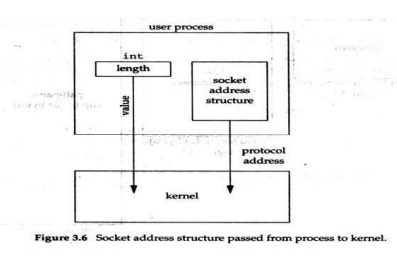
The four functions accept(), recvmsg(), getsockname() and getpeername() pass a socket
address structure from kernal to the process, the reverse direction form the
precious scenario. In this case the length is passed as pointer to an integer
containing the size of structure as in
struct
sockaddr_un cli; // Unix domain// socklen_t len;
len =
sizeof (cli);
getpeername
(unixfd, (SA *) &cli, & len );
The reason that the size changes from an integer to be a pointer to an integer
is because the size is both value
when the function is called ( it tells the kernal the size of the structure so
that the kernal does not write past the end of the4 structure when filling it )
and it is the result when the
function results (It tells the process how much information the kernal actually
stored in the structure). This type of argument is called value – result arguments.
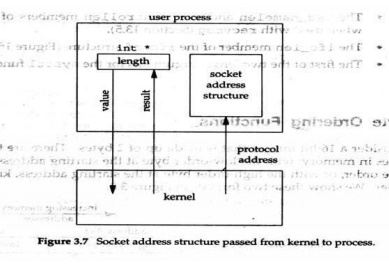
With variable length socket address structure,
the value returned can be less than the maximum size of the structure.
Byte
Order functions: There
are two ways to store the 2 bytes in the memory. With the low order byte at the starting address known
little endian byte order a or with high order byte at the starting address
known as big endian byte order.
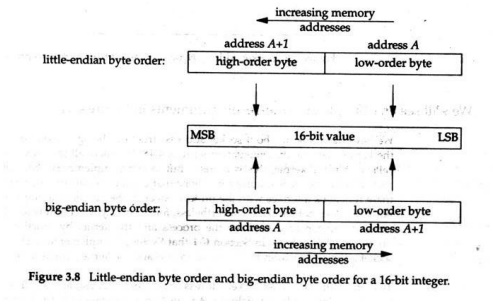
The terms little
endian or big endian indicate which end
of the multi byte value , the little end or the big end is stored at the starting address of the
value. Different systems use different orderings. For example, PowerPC of IB,
sparc of Sun Soloaris, Happal of HP all use big endian while i386 PC of BSDi
and i586 pc of Linux use little endian. The byte order used by a given system
is known as the host byte order. As network programmer, one need to deal with
the different byte orders. That is the sending and receiving protocol stack
must agree on the order in which the bytes of these multibyte fields are
transmitted. Internet protocol uses big endian byte ordering for these
multibyte system.
Normally, the address structure may be
maintained in the host byte order system. Then it may be converted into network
byte order as per requirement. However, Posix.1g specifies that the certain
files in socket address structure be maintained in network byte order .
Therefore, there are function that convert between these two byte orders.
#
include <netinet/in.h>
uint16_t htons(uint16_t host16bitvalue);
uint32_t htons(uint32_t host32bitvalue);
Return
value in network byte order.
uint16_t ntohs(uint16_t net16bitvalue);
uint32_t
ntohs(uint32_t net16bitvalue);
Returns
value in host byte order.
Appropriate function are called to convert a
given value between the host and network byte order. On those systems that have
the same byte order as the Internet protocols (big endian), these four
functions are usually defined as null macros.
Related Topics